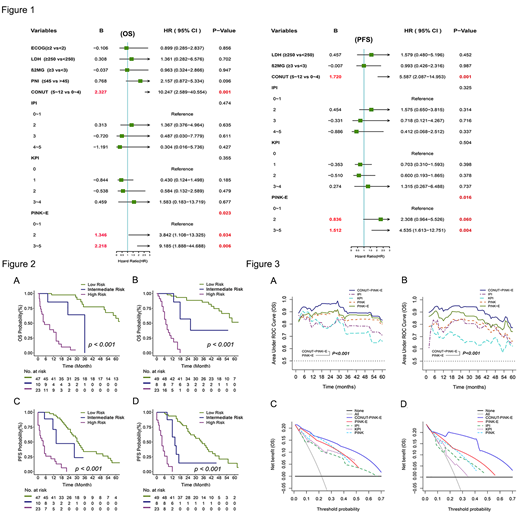Abstract

Introduction: Patients with aggressive lymphomas are at high risk of losing body resources, resulting in malnutrition, immunodeficiency, impaired life quality and inferior outcomes. Nutritional status is closely associated with the development and treatment arrangements of malignancies, but often neglected in the prognostic assessment. Thus, this study aimed to explore the prognostic significance of nutrition-related parameters in extranodal NK/T-cell lymphoma (ENKTL), an aggressive lymphoma with dismal outcomes.
Methods: We retrospectively analyzed patients diagnosed with ENKTL between 2011 and 2020 from Shandong Provincial Hospital and Affiliated Hospital of Qingdao University. The observation endpoints were overall survival (OS) and progression-free survival (PFS). Univariate (UVA) and multivariate (MVA) Cox regression analyses were conducted to examine the significance of variables at diagnosis on OS and PFS. A reformative nutrition assessment-incorporated score system was constructed based on the MVA results. Its performance was tested in the training and validation cohort from multiple aspects, including calibration, discrimination and clinical utility.
Results: A total of 160 patients with a median age of 50 (39, 58.75) years and male predominance (67.5%) were included. The prognostic significance of two emerging nutritional indexes, prognostic nutritional index (PNI) and controlling nutritional status (CONUT) score, was assessed. UVA analysis showed PNI was a meaningful marker to OS (HR 2.275, P=0.014) but not to PFS (HR 1.653, P=0.089) while CONUT score was a significant predictor not only to OS (HR 29.385, P<0.001) but to PFS (HR 12.516, P<0.001). MVA analysis further verified that CONUT score could independently predict OS (HR 10.247, P=0.001) and PFS (HR 5.587, P=0.001) in addition to prognostic index of natural killer lymphoma plus EBV (PINK-E), another independent marker (PINK-E=2, HR 3.842, P=0.034, PINK-E=3/4/5, HR 9.185, P=0.006 for OS; PINK-E=2, HR 2.308, P=0.06, PINK-E=3/4/5, HR 4.535, P=0.004 for PFS) (Figure 1).
Based on this finding, a modified prognosis scoring tool, CONUT-PINK-E, was developed from the training cohort (TC) and tested in the independent external validation cohort (VC). The novel model contains six factors, age≥60 years old, Ann Arbor III/IV stage, distant lymph node involvement, non-nasal type, detectable EBV-DNA in blood and CONUT score≥5 (moderate and severe malnutrition). CONUT-PINK-E differentiated patients into low-, intermediate- and high-risk grades according to the imparities of survival probability revealed by Kaplan-Meier curves. Significant survival differences existed among three risk grades that the median OS was 74, 36, 5 months and median PFS was 31, 14, 4 months, respectively, for the low-, intermediate-, high-risk group (P<0.001) in TC and the corresponding data were 72, 26, 7 months and 35, 14, 4 months in VC (P<0.001, Figure 2).
Subsequently, the superiority of CONUT-PINK-E was examined by comparison with international prognostic index (IPI), Korean Prognostic Index (KPI), Prognostic index of natural killer lymphoma (PINK) and PINK-E. The 1- to 5-year time-dependent areas under receiver operating characteristic curve (AUCs) hinted that CONUT-PINK-E (TC: 0.832-0.961, VC: 0.773-0.937) possessed higher discrimination than IPI (TC: 0.710-0.785, P<0.001; VC: 0.646-0.840, P<0.001), KPI (TC: 0.659-0.826, P<0.001; VC: 0.623-0.691, P<0.001), PINK (TC: 0.802-0.865, P<0.001; VC: 0.663-0.842, P<0.001) and PINK-E(TC: 0.815-0.902, P<0.001; VC: 0.741-0.894, P<0.001) (Figure 3A, 3B). Decision curve analysis plainly showed CONUT-PINK-E brought higher clinical net benefits than IPI, KPI, PINK and PINK-E in forecasting OS and PFS of ENKTL (Figure 3C, 3D). In addition, net reclassification index (NRI) and integrated discrimination improvement (IDI) conformably demonstrated that CONUT-PINK-E achieved significant improvements than the prior stratification tools.
Conclusion: This is the first time that CONUT score was recognized capable of acting as an independent prognostic marker in newly-diagnosed ENKTL patients. More importantly, the first risk score covering nutritional status assessment for ENKTL, CONUT-PINK-E, was proposed and presented striking performance. The newly-built model could deliver vital reference to the risk stratification and comprehensive managements of ENKTL patients.
No relevant conflicts of interest to declare.
Author notes
 This icon denotes a clinically relevant abstract
This icon denotes a clinically relevant abstract


